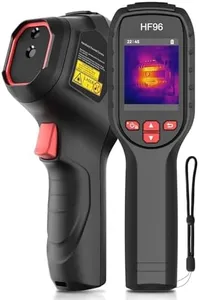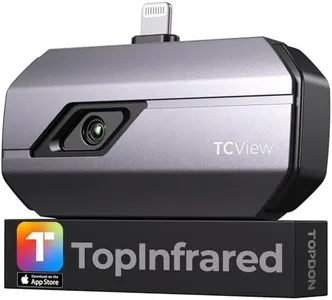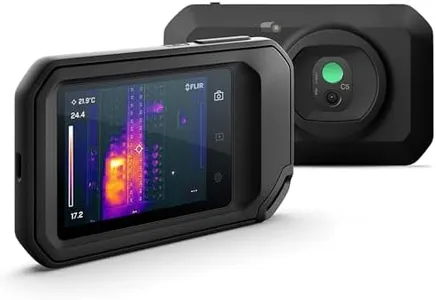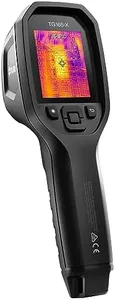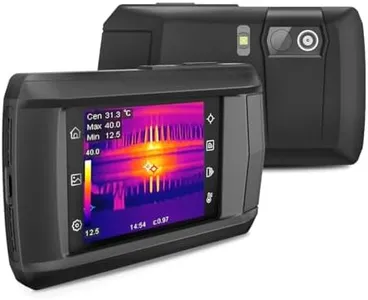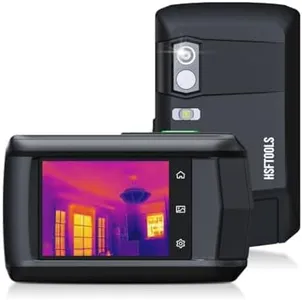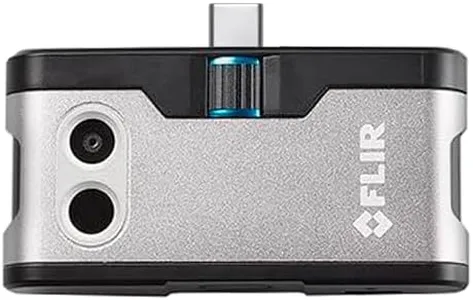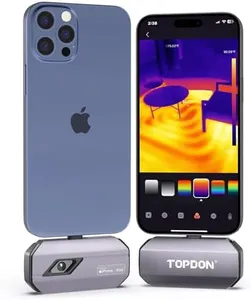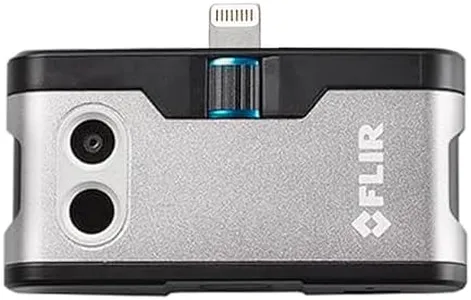10 Best Thermal Cameras 2025 in the United States
Our technology thoroughly searches through the online shopping world, reviewing hundreds of sites. We then process and analyze this information, updating in real-time to bring you the latest top-rated products. This way, you always get the best and most current options available.

Our Top Picks
Winner
HSFTOOLS HF96 Thermal Camera, Super Resolution 240 x 240, Thermal Imaging Camera with Laser Pointer, 96 x 96 IR Resolution, 25 HZ Infrared Camera,-4°F to 1022°F, 50°FOV, 8h Battery Life Thermal Imager
Most important from
377 reviews
The HSFTOOLS HF96 Thermal Camera offers a range of impressive features, making it suitable for various inspection scenarios. It boasts a super resolution enhancement from 96x96 to 240x240, which significantly improves image clarity, making it easier to identify issues. The thermal sensitivity of 50mk ensures that even small temperature differences are detected, and the device covers a wide temperature range from -4°F to 1022°F, making it versatile for different environments.
The 50° field of view provides broad coverage, and the 25Hz refresh rate allows for smooth viewing during inspections. Additionally, the built-in laser pointer and selectable color palettes enhance usability in different conditions. The USB Cast Screen feature is particularly useful for live-sharing detailed inspections with others. The HF96's durability is commendable, with an IP54 rating and the ability to withstand drops from up to 6.6 feet.
The battery life of up to 8 hours is sufficient for extended use, and its built-in memory can store around 30,000 images. However, it’s worth noting that while the super resolution enhancement is beneficial, the base resolution is still 96x96, which may not be adequate for the most demanding tasks. The device’s size and weight (1.43 pounds) should be considered for portability, and while the temperature accuracy is within ±2%, this might be a limitation for extremely precise measurements. The HF96 is a robust and reliable thermal camera with excellent features for general use but may fall short for high-precision professional requirements.
Most important from
377 reviews
TOPDON TC002 Thermal Camera for iOS (iPhone & iPad), 512 x 384 Super Resolution, 256 x 192 IR High Resolution, Thermal Imager, Thermal Imaging Camera, -4°F~1022°F Temp Range, Support Video Recording
Most important from
654 reviews
The TOPDON TC002 Thermal Camera for iOS presents an impressive resolution of 512 x 384, which translates to clearer and more detailed thermal images for users. This is a significant improvement over standard resolutions, making it easier to identify temperature variations. With a thermal sensitivity of 40mK, it can detect minute changes in temperature, which is beneficial for detailed inspections.
The camera has an extensive temperature range of -4°F to 1022°F, allowing it to handle various environments and applications, from winter conditions to high-temperature industrial settings. Its 25Hz refresh rate ensures smooth temperature readings with minimal flickering, enhancing the user experience. Additionally, the TC002 features adjustable sharpness and contrast to further improve image clarity and detail, and its field of view is adequate for most inspection tasks.
The device is designed exclusively for iOS devices with a Lightning port, making it a plug-and-play option for iPhone and iPad users, though it is not compatible with Mac. Battery life is reliable, with the camera drawing low power, allowing it to work for 6-8 hours on a fully charged iPhone and 8-10 hours on a fully charged iPad. Durability and build quality are solid, with a compact design that makes it easy to carry and store. However, users with newer iPhone models (iPhone 15 and later) will need a different version, the TC002C. The camera also includes useful features like picture-in-picture mode, image rotation, and multiple color palettes, adding to its versatility. Suitable for various professionals, including home inspectors, HVAC technicians, electricians, and farmers, the TOPDON TC002 is a practical tool for precise temperature measurement and thermal imaging.
Most important from
654 reviews
FLIR C5 Compact Thermal Imaging Camera with WiFi: High Resolution Infrared Imager for Inspection, Electrical/Mechanical, Building, and HVAC Applications
Most important from
1193 reviews
The FLIR C5 Compact Thermal Imaging Camera is a versatile and portable option for various inspection tasks such as electrical, mechanical, building, and HVAC applications. It offers a good resolution of 160 x 120 pixels (19,200 pixels), which is sufficient for detailed thermal imaging and troubleshooting. The camera's thermal sensitivity (NETD) ensures that it can detect even minor temperature variations, enhancing its diagnostic capabilities. It has a wide temperature range from -20 to 400°C (-4 to 752°F), making it suitable for a variety of environments and applications.
The patented MSX technology embosses visual details onto thermal images, making them sharper and easier to interpret, which is a significant advantage for professionals who need clear images for their reports and diagnostics. The FLIR C5 also includes WiFi connectivity, allowing users to directly upload images to the FLIR Ignite cloud and easily share reports with clients. The field of view is adequate for most applications, and the image frequency ensures smooth thermal imaging.
On the downside, the camera relies on AAA batteries, which might require frequent replacements, and it is relatively small in size, which could be a plus for portability but might limit its screen size for detailed on-the-go analysis. The build quality is robust, with waterproofing adding an extra layer of durability. With a 2-year parts and labor warranty and a 10-year detector warranty, it offers good long-term value. This camera is particularly useful for professionals in HVAC, building inspections, and electrical/mechanical diagnostics who need a reliable and portable thermal imaging solution.


